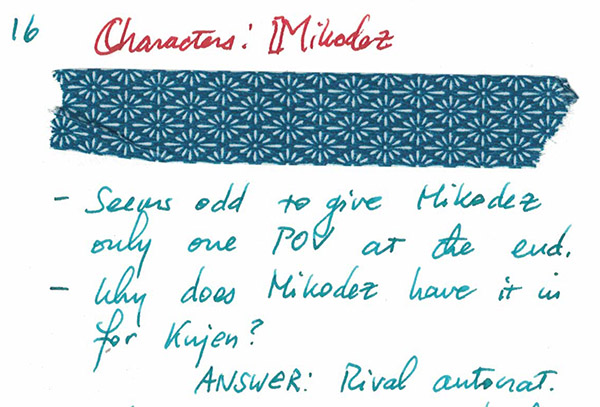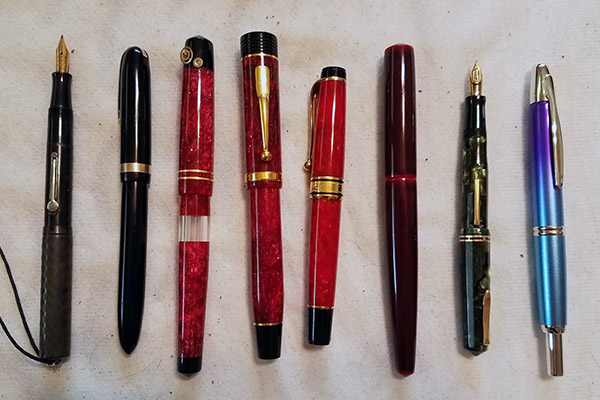In this ongoing series, we ask SF/F authors to describe a specialty in their lives that has nothing (or very little) to do with writing. Join us as we discover what draws authors to their various hobbies, how they fit into their daily lives, and how and they inform the author’s literary identity!
I have a history of not being picky about my writing implements, which makes it all the more hilarious that I got sucked into the rabbit’s hole that is fountain pens. I’ve used everything from the ubiquitous Monami ballpoints that you find in South Korea to cruddy No. 2 pencils (hello, Scantron!) to glitter gel pens. Thumbnail sketches and math problems take on a certain glow when you do them in glitter gel pen.
My first fountain pen was a gift from a generous benefactor, but developed a leak and didn’t last long. I forgot about fountain pens for a while until I came across a website and fell in love with examples of flex-nibbed calligraphy, which takes advantage of a nib’s ability to flex to create line width variation. In real life, the better way to get into this is through dip pens, which are cheaper and flexier, as opposed to with a (usually expensive) vintage fountain pen whose nib you might damage with this sort of tomfoolery. But I was entranced. I bought one anyway.
I spent the next several years reading up on fountain pens, messing with fountain pens, and writing with fountain pens. This is a hobby you can either do on the cheap (relatively speaking), with less expensive pens like the Lamy Safari or Pilot Metropolitan, or at the far end, with limited edition Montblanc or Japanese maki-e pens running to the thousands of dollars and beyond. I’m somewhere in the middle.
What I like about fountain pens as a hobby is that there’s something for almost every budget. The disposable Pilot Varsity is affordable and is very reliable; the refillable Platinum Preppy, although fragile, runs under $5 if you just want to try things out. I like that fountain pens are frequently beautiful (although beauty is, of course, in the eye of the beholder) and that they come with a bewildering variety of filling mechanisms if you like to geek out about that stuff. (For a first-timer, I recommend a cartridge/converter pen–and be aware that some companies make proprietary cartridges/converters, so be sure to get the right one for your pen!) I like being able to choose from the wild variety of ink colors. Your options are more limited if you stick to cartridges, but if you opt to fill from bottled ink, the sky’s the limit. There are even inks that come with sparkling gold or silver particles in them if that’s what your heart desires, although you have to be careful to use them in a pen that won’t clog.
Most of all, I got into fountain pens at a time when reading was exhausting for me and I needed a low-effort hobby. A fountain pen is something that I can appreciate and use with very little work, as opposed to a book. I can simply look at and admire the beauty of a well-made fountain pen. Or I can write with it, and that’s pleasurable too. Even when I’m not writing fiction with a fountain pen, I do a lot of journaling. No one else is going to read those journals, but the process of sitting down with a pen and notebook and writing out my thoughts is soothing. I also like sketching with my fountain pens. Some of them are better for this purpose than others, but the results are fun.

As it turns out, I wrote the rough drafts of Ninefox Gambit and Raven Stratagem (and also Revenant Gun) in fountain pen. For Ninefox Gambit, I mostly used my Webster Four-Star and Waterman 52V, both vintage pens. (Jedao’s signature gun, the Patterner 52, was inspired by the Waterman’s name. Someday I’ll acquire an actual Waterman 52, not just the vest pocket version–which is what the “V” means.) I wish I could show you scans of Ninefox Gambit or Raven Stratagem‘s rough drafts, because I used every color of ink I could get my hands on and the results looked like My Little Pony vomit, but we were flooded out last August and the notebooks and papers were among the casualties. I still write longhand revision notes, however, and I’m considering going back to doing longhand drafts because something about the physicality of the process helps me think.
 Yoon Ha Lee’s space opera novel Ninefox Gambit and its sequel Raven Stratagem are available from Solaris Books. He lives in Louisiana with his family and an extremely lazy cat, and has not yet been eaten by gators.
Yoon Ha Lee’s space opera novel Ninefox Gambit and its sequel Raven Stratagem are available from Solaris Books. He lives in Louisiana with his family and an extremely lazy cat, and has not yet been eaten by gators.










